Clicking on Everything at Random
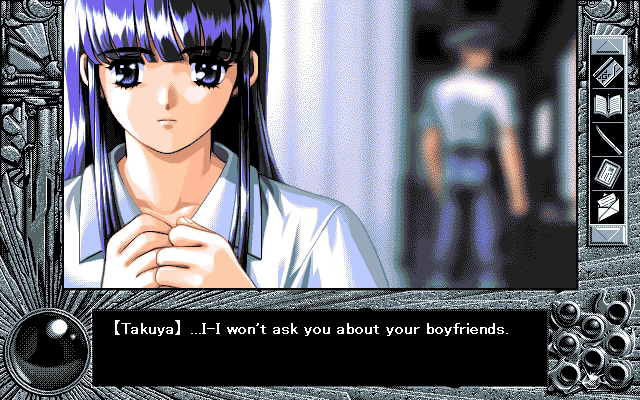
While the narrative is more involved and dramatic than King’s Quest V, YU-NO is still a ’90s adventure game with the unfortunate trial-and-error design that implies. Initially, the freedom and nonlinearity of the ADMS section feel liberatory. However, advancement through time requires the player to perform certain strict sequences of events, rarely with any logical connection between them. A deep aimlessness pervades the design. YU-NO almost never offers guidance on where to go or what to do. This would be acceptable if many opportunities for interactions and new moments presented themselves, but they do not. The result is that Takuya might have a conversation with Ayumi but then wander Sakaimachi for several real-life minutes for no reason until by random chance he stumbles into the next disconnected story event. Clicking at random is near-constant, and often I would visit every available location and still nothing would happen. Aside from the boredom and frustration, this gameplay also characterizes Takuya as a brainless klutz who has no idea what he is doing or where he is going.
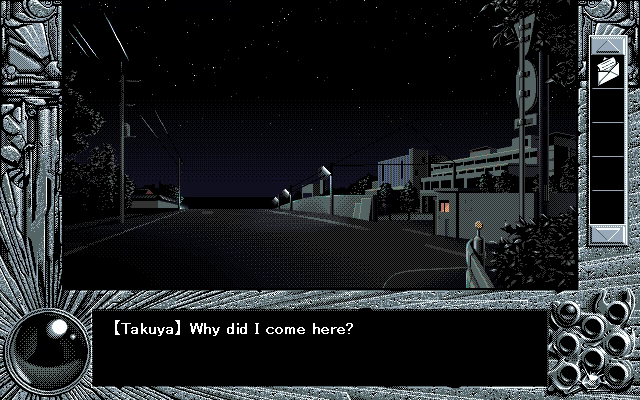
Takuya’s characterization as a bumbling, oblivious oaf is consistent through writing as well as gameplay. He constantly forgets basic information, such as how, on Kanna’s route, he leaves Kanna’s apartment to get antipyretics and instantly forgets what he is doing (his ADHD is more severe than mine). Takuya is also so slow on the uptake that it would be hilarious if the emotional stakes were not so high—or if the player checks out long before I did.
To stick with the Kanna route for examples, when Takuya opens the door to Kanna’s apartment, he finds her passed out on the floor because the Hypersense Stone she depends on for survival is increasingly losing its charge. (She depends on this stone because she is part of the “Celestial race” of Dela Grante. So is Takuya, but he must have lucked out genetically.) Instead of letting the player help Kanna, the video game mandates that the player click around aimlessly for a while as Takuya wonders if this person who is in Kanna’s apartment and who has Kanna’s face, hair, and clothes is Kanna. Who else could she be? Takuya already knows she is ill and faints sometimes. Why prolong the scene like this?
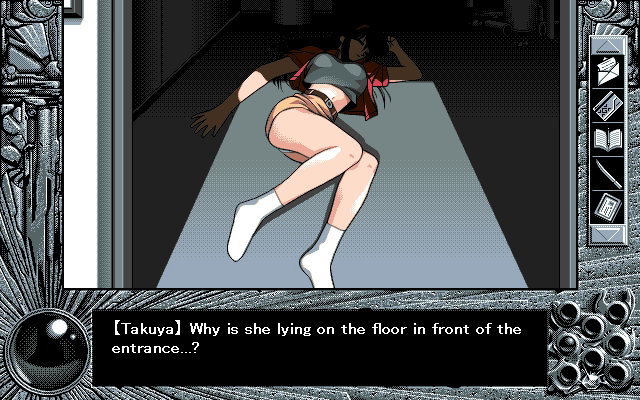
This sequence is not half as enraging or, in the depths of its stupidity, hilarious as later on, when Takuya watches Houjou hold Kanna up at knifepoint. Since this is the rare situation in which Takuya’s over-the-top-aggressive masculinity might be useful, the blowhard instead keeps repeating that he needs to get a sense of the situation while the player clicks around more or less at random for a few minutes. Yes, Takuya, the creepy guy you hate who is after Kanna’s necklace and you now know is working for an alien monster with brainwashing powers is holding Kanna up at knifepoint, demanding her necklace. Golly, what could be going on?
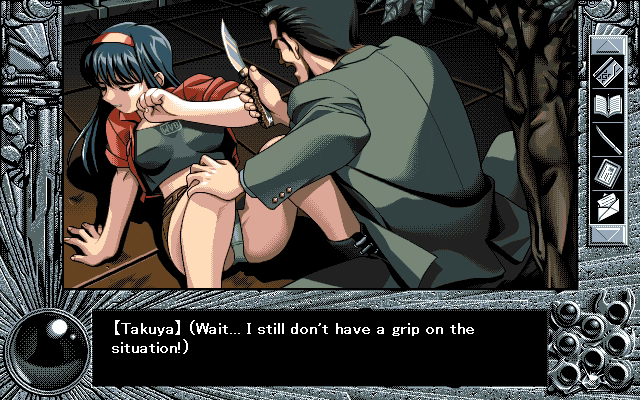
I still do not know how YU-NO determines when these sequences end. It is not when the player reads every possible line of text. From repeating the scene when Kaori has Takuya search Ayumi’s office at the Geo Technics headquarters, I know it is also not when the player clicks on the correct spot. Likely it has to do with achieving a certain arbitrary number of clicks and/or clicking on certain objects (and/or feminine anatomy) in a specific and arbitrary order. Writing this in retrospect, I find the amount of wasted time funny, like a prank Elf pulled on me. But for the poor sod playing YU-NO, where the filler totals not minutes but hours, to call the gameplay and writing a snooze is an understatement. As I have mentioned in, among other places, my video about Idol Hakkenden and my review of SNATCHER, similar flag-hunting sequences are also, unfortunately, standard among Japanese adventure games of the ’80s and ’90s. Not an original design flaw, in YU-NO it simply occurs in a point-and-click interface instead of in menus. A “revolutionary” video game would have broken with this design tradition, not carried it on exactly.
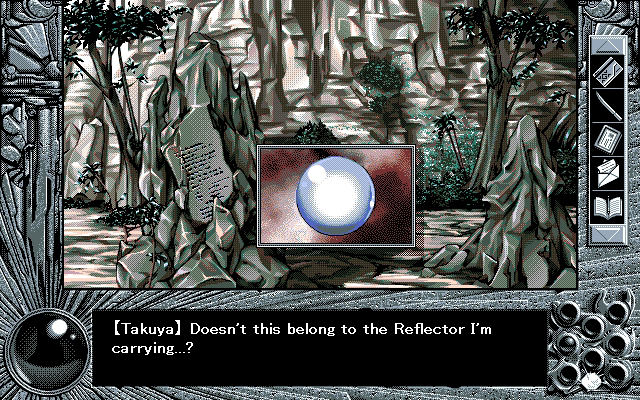
Except for the one inside the clock in Koudai’s study, which the stylish introductory cutscene depicts Koudai hiding, none of the jewel locations make narrative sense. For example, in an inexplicable and hostile design choice, the player can only find a certain jewel by reading the same expository document in Takuya’s room twice. People complain about accidentally asking Kaepora Gaebora to repeat exposition in Ocarina of Time, but imagine if the only possible way to attain one of that video game’s Spiritual Stone MacGuffins was deliberately repeating this exposition and that at no point did the designer see fit to drop a hint. Antagonistic design was all too common in ’90s adventure games, albeit less so in Japan, but does YU-NO no favors.
Takuya, and hence the player, simply must hope they stumble across the jewels at random. Trial-and-erroring this much content might take well over a hundred hours, skipping through same three days’ worth of scenes over and over and over again to return to divergence points to see what might, maybe, make a difference this time. One particular divergence point involves choosing whether or not to return Mio’s notebook, even though there is no rational reason Takuya would not do so in this scene.
Combined with certain unintuitive dead ends on several timelines and the mountain of fluff dialogue, exacerbated by the time loop structure’s mandated repetition of many of the same already frequently minor events again and again, a huge portion of the player’s time with YU-NO consists of filler. Witty or just bizarre descriptions of the environment and comments about women’s breasts might be amusing at first but wear out their welcome the tenth time the player clicks through them. Perhaps YU-NO lures players in using the sunk cost fallacy. The necessity that the player behave irrationally all the time and Takuya’s constant need to repeat information over and over to grasp obvious facts must be among those ways YU-NO cerebrally challenges logic that Sorlie refers to.